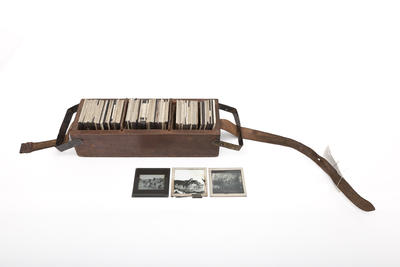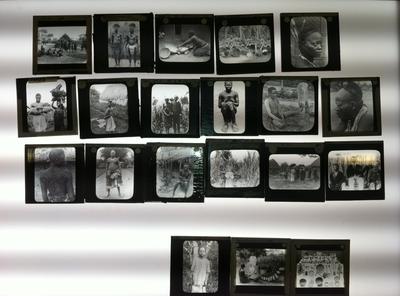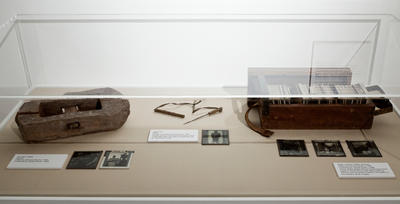Interpreting Lantern Slides for an Exhibition
A little over a century ago, around 1907 scandal shook the London press with allegations that British chocolate manufacturers were using slave labour to produce cocoa. It was discovered that workers captured as slaves in Angola, were forced to become labourers for five years before being returned home. In reality, very few survived or returned home. Joseph Burtt, a journalist and the original owner of this box of slides, went to Angola to investigate these allegations.
Copyright Tyne & Wear Archives & Museums.The slides in the box are very diverse and imbued with enough complex histories to curate an exhibition just using this one object. We chose to tell just one story relating to Angolan slavery in our exhibition ‘The Curious Case of…’ at the Great North Museum: Hancock, Newcastle upon Tyne, UK (Tyne & Wear Archives & Museums service Service) which formed part of Journeys of Discovery, the North East strand of Stories of the World, part of the Cultural Olympiad 2012. A key aim of the exhibition was to involve interested parties to share the interpretation with the young volunteer curators, using the exhibition as the mouthpiece of those traditionally excluded as part of museum curation. As a result a local group, CultuRISE, many of whom have Angolan roots, were asked to add a contemporary Angolan voice to the interpretation.
The question arose however, how to understand this box of lantern slides. What kind of object was it? And how might it be displayed and interpreted to a contemporary audience? Working with Elizabeth Edwards of PhotoCLEC we realised that the slides were not all taken at the same time. Our first challenge was to identify a selection that was linked to the story of Burtt’s slavery investigation. We categorised the slides, using both visual and material evidence, grouping them by geographical area as well as thematically, separating out those which concerned the narrative of slavery in the Portuguese colonies to use within the exhibition.
The slides depict a wide range of scenes from across Africa at the turn of the last century; images of Egypt, Kikuyu pastoralists in Kenya, shots of Victoria Falls, big game hunting as well as peoples of Southern Africa. We realised that some of the images might have been produced commercially, after seeing them reproduced in early twentieth century ethnography publications: images such as those of Livingstone and Philae Temple. Other images seem to have been taken personally; images showing landscapes, life, health care and ceremonies.

 Burtt did not photograph all the images in his slide collection. The
examples above were also shown in the publications ‘Customs of
the World’ (1913) and 'Dawn in the Darkest Africa' (1912) respectively.
Burtt did not photograph all the images in his slide collection. The
examples above were also shown in the publications ‘Customs of
the World’ (1913) and 'Dawn in the Darkest Africa' (1912) respectively.
Joseph Burtt travelled to Angola, commissioned by Cadburys with the backing of other major chocolate manufactures in the UK and Europe (Rowntree, Fry and the German firm Stollerwerck), to investigate allegations into the use of slave labour on cocoa plantations in Portuguese West Africa. The Cadbury family, and indeed the other families involved in cocoa manufacture in Britain, were Quakers with longstanding concerns over the rights and conditions of their workers and vehemently anti-slavery.
Despite not taking all these photographs himself we think Burtt put this collection together to report on aspects of Angolan life at that time.
Copyright Tyne & Wear Archives & Museums. This image shows the grouping of slides to use in the exhibition.
The second challenge was to present the slide selection and interpretation in a sensitive manner. In discussion with Elizabeth Edwards we came up with the idea of presenting the slides in the format of a traditional magic lantern slide show. Embracing the traditional way of showing slides and films rather than a typically Western ‘art gallery’ style of mounting pictures and paintings on a wall, we strove to avoid what could be seen as a voyeuristic way of presenting the images. A small room was constructed in the exhibition space where the slideshow was projected onto a white sheet with a mismatch of chairs. This attempted to reproduce the conditions of seeing such lantern slides as an historical experience.
After talking with Elizabeth Edwards and reading a case study on Into the Heart of Africa (an exhibition in Canada, 1989 in which an ironic use of missionary photographs was understand as highly offensive by some constituencies of exhibition visitor), the decision was made not to replicate the captions written on the slides within the museum’s texts.. Some of these contain what are now derogatory epithets, and using quotation marks does not necessarily clearly indicate to an audience that this is the original view point and not that of the curator. The original captions and comments were not however obscured on slides displayed. They clearly formed part of the original historical object itself and as the opinion of the owner, an historical reading.
The box of slides itself was shown in a case outside of the slide projection room. Most slides remained inside the box, six slides were laid out alongside other items from the collection that could be related to scenes shown in the slide. A wooden slave shackle, also donated by Joseph Burtt, and a jigger pin which is related to a slide which depicts a woman with a chigoe/jigger flea infestation in her feet.
Copyright Tyne & Wear Archives & Museums. This image shows the case which supported the slideshow.
Generating visitor dialogue in the exhibition space and online was a key objective for the group of young curators. By engaging CultuRISE we hoped to add their voice to our interpretation and develop meaningful dialogue around the issues highlighted in the exhibition. Because the slides showed a story of life and slavery in Angola, Angolan born members of a sister project, CultuRISE, were consulted to act as representatives of modern Angola offering their own opinions and interpretation of the slides.
Members of CultuRISE were shown the slides and we discussed their reactions and how they felt about the subject matter. They were pleased that Angolan history was being highlighted and that they had an opportunity to share views on contemporary Angola. The conversation was recorded and edited as a voice over to the slide selection so as to provide layers of interpretation for the visitor.
While CultuRISE members felt they could not comment extensively on the slavery aspect of the story as they had never experienced it personally, one participant said; ‘For me, it (slavery) makes my grandmother who she was, my mum who she is and who I am becoming. It is just a story to tell, it’s like a part of us’. However, the group had much to say about the changes that have happened in Angola, detailing the differences and similarities between then and now. Topics that generated much debate included the subject of education, as Angolan history before the arrival of the Portuguese is not widely taught, the impact of witch doctors on Angolan communities and traditional wedding customs changing over time under Portuguese influence.


Copyright Tyne & Wear Archives & Museums. This image shows two slides which provoked the most debate among CultuRISE. The first shows a witch doctor, the second a wedding ceremony.
In choosing to exhibit the slides in the way we did, we hope our audience experienced a rounded view of a difficult subject matter which was accessible and sensitive to issues that could arise from exploring slavery as part of a museum exhibition. It has also demonstrated that contentious issues can and should be tackled within museums by working together with museum staff, academic experts, volunteers and community engagement. Indeed, the display was described as a highlight of the exhibition on a review on the Museum Ethnographers Group blog
(http://museumethnographersgroup.blogspot.co.uk/2012/09/review-curious-case-of.html)
To see the exhibition slideshow follow this link http://vimeo.com/45156813. The page will ask for a password before viewing…….Password = CultuRISE
William Muse, Volunteer Curator
The Curious Case of… held at the Great North Museum: Hancock, June – September 2012.
The Curious Case of… is part of Journeys of Discovery, a Stories of the World project, at the heart of the London 2012 Cultural Olympiad. Journeys of Discovery explores the museum collections of north east England through the eyes of young adults. Working in partnership with communities from around the world, creative artists, and museum professionals, they have explored the personal stories behind museum objects whilst considering their 21st century relevance.
Extra information is displayed on the project website www.journeysofdiscovery.org.uk
And on a personal blog which acted as a research journal http://extracurious.wordpress.com/


